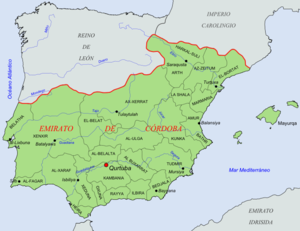Battle of Guadalacete
| Battle of Guadalacete | |||||||
|---|---|---|---|---|---|---|---|
| Part of the Reconquista | |||||||
 Map of the Emirate of Cordoba. | |||||||
| |||||||
| Belligerents | |||||||
|
Toledo rebels |
| ||||||
| Commanders and leaders | |||||||
|
Musa ibn Musa Ibn Balyus | Muhammad I of Córdoba | ||||||
| History of Spain |
|---|
 |
| Timeline |
The Battle of Guadalacete was fought in 852 between a coalition of troops from the Kingdom of Asturias and the Kingdom of Navarre, and a force of troops from the Muslim Emirate of Córdoba under the command of Muhammad I of Córdoba. The outcome was a Muslim victory.
Context[edit]
After the death of Emir Abd ar-Rahman II in the year 852, the population in the area around Toledo rose in revolt as they had done on many previous occasions. Their reasons were both internal, such as corrupt governance, and external as they identified more with the Christian kingdoms to the north. They also frequently were harassed by the Mozárabes people who resided in the Muslim borderlands. Hence, the people of Toledo rose in arms, seeking the assistance of the Kingdom of Asturias and Basques as is reported by Ibn Khaldun, quoting verbatim from Spanish-language chronicles of the tenth century:
The people of Toledo asked for the help of the King of Galicia and the King of the Basques, who came to free them with the help of the city's men. The Toledo army formed by the union of the people of Toledo and the Christian kings, saw that of the Emir (very small) and went to the banks of the Rio de Guadalacete and fought with fervor, routing the Emir. He retreated to the lands to the south, followed by the army of Toledo which fell into an ambush, as the bulk of the arab army had anticipated this movement. This resulted in the massacre of more than 8,000 souls, giving victory to the Muslim empire and crushing the rebellion of Toledo.[1]
The battle[edit]
The organized forces of Muhammad I were easily able to rout the town rabble and their Christian men at arms from Asturias and Navarre. They were however, unable to take the actual city for another 7 years.
Consequences[edit]
After the Toledan and Asturian forces were defeated at Guadalacete, Muhammad I failed to capture the city. The rebellion, which was inspired by the Christian clergy and aided by the Muladi, was prolonged until the year 858 due to a continued desire for independence from Cordoba. In 858 Muhammad finally conquered the city and jailed Bishop Eugenio; he was executed the following year.[2]
See also[edit]
References[edit]
- ^ Translated from the Spanish translation of ibn Khaldun, "Los toledanos pidieron la ayuda del Rey de Galicia y del Rey de los Vascones, que acudieron a liberarlos con la ayuda de la gente de la ciudad. El ejército de Toledo formado por la unión del pueblo toledano y los reinos cristianos, viendo al del emir (muy reducido), salieron a los márgenes del río Guadalacete y combatieron con fervor derrotando al emir. Éste se retrajo hasta tierras más al sur, siendo seguido por el ejército de Toledo que cayó en una emboscada, ya que el grueso del ejército árabe estaba esperando ese movimiento. Todo esto produjo una matanza de más de ocho mil almas, dando la victoria al imperio musulmán y aplastando así la rebelión de Toledo."
- ^ "Historia del Condado de Castilla". Archived from the original on 17 April 2012. Retrieved 5 June 2012.
- "Historia del Condado de Castilla". Archived from the original on 17 April 2012. Retrieved 5 June 2012.
- "Batalla de Guadalacete". Retrieved 5 June 2012.
